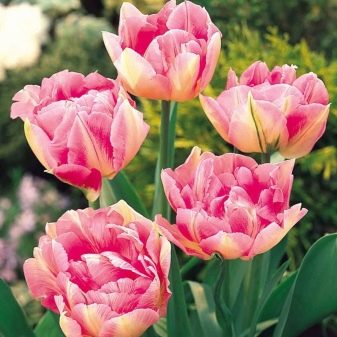All about peony tulips

One of the most popular spring plants are tulips, which can decorate any flower garden. Among them, there are a large number of different hybrids that look more like other plants in appearance. For example, you can find peony tulips.

Peculiarities
To date, breeders from different countries have bred more than 1.5 thousand different types of tulips. Among them, terry varieties, a bit resembling peonies, are very popular. For the first time such beauties were presented to the public in 1613. Since they had a terry corolla, which was composed of two or even more rows of petals, the peony tulips got the name Tulipa Double Early, it translates as a double tulip.
These plants differ in some characteristics. So, judging by the height of the stems, they can be:
- tall - in this case, the height of the stem reaches 50 centimeters;
- medium, which grow up to 35 centimeters;
- dwarf - despite their beauty, they grow only up to 10 centimeters.



In addition, they are also distinguished by their flowering time, which can last from two weeks to a month. In addition, peony tulips can have a different shape of the bud, for example, cupped or in the form of a glass. In a circle, they can be from 9 to 16 centimeters.
Advantages and disadvantages
It is worth noting that this plant has more advantages than disadvantages. The first should include the following:
- beautiful and lush bloom;
- can be used not only for growing on flower beds, but also for creating alpine slides or decorating sidewalk paths;
- flowering lasts quite a long time;
- reproduction can be carried out in different ways.


The disadvantages include only the fact that the plants give very few daughter bulbs, and also poorly resist various viral diseases.
Popular varieties
There are many varieties of this plant with the names of the cities or breeders who bred them. Among them you can find both red and white, and even tulips with various blotches. It is worth noting the most popular among them.
- "Exotic Emperor"... The unusual color of these tulips literally attracts the eyes of all passers-by. The pale white bud is covered with a lot of green strokes. Outside the flower, the petals are quite dense, which makes them more persistent. Very often this variety is used for cutting or for decorating gardens or parks.


- Double Red Reading Hood... This variety differs from its relatives in that it does not bloom in the shade. However, in a well-lit area, it strikes the eye with lush and rather large scarlet buds. Often used to create alpine slides.


- "Monte Carlo"... This is a fairly early variety that is very difficult to distinguish from peonies, especially on sunny days when it opens fully. Differs in lemon color, which makes it possible to see it from afar. It is often used for artificial potting.


- Another peony tulip is Peach Blossom. It is almost impossible to distinguish it from peonies, since it has the same shape and the same pink color. It blooms for a very long time, practically from 3 to 4 weeks.


- Beautiful thick double variety "Royal Acres" striking in its lilac color. It is most often used for growing in flower beds, as well as for forcing in flowerpots.


- Mount Tacoma. This late variety with delicate white double buds is indistinguishable from peonies. Flowering lasts almost 3 weeks. It is more used for cutting.


- It is impossible not to note another peony tulip variety - "Humilis Tet-a-Tet"... Its unusual buds are red in color. You can see small green lines on them. However, it is a dwarf variety, and its stem grows no more than 10 centimeters. Therefore, it is used more for creating alpine slides or on flower beds.


How to grow?
Having seen such beauty at least once, everyone thinks about growing this flower, but not everyone knows how to do it. First you need to purchase planting material, and this can be done either on the Internet or in flower shops.
The best time to buy is September. The bulbs should be medium, with a fairly dense skin, brown in color. Before planting, be sure to prepare a place for tulips. It should be well lit and protected from winds and drafts. Besides, you should not plant bulbs where groundwater is close, so that the plantings do not rot in the future.

It is very important that the soil is not highly acidic. If this is the case, then you can add a little lime to this place, or take 1 glass of ash, 1 glass of superphosphate with three kilograms of peat and mix it all with the ground where future tulips will be planted. This mixture is for one square meter. In addition, this option is also considered a fertilizer. And also the earth must be well shed with a manganese solution in order to kill all the pests that are in the ground.

After preparing the soil, you can start planting the bulbs. It is necessary to maintain a distance of at least 18-19 centimeters between the rows, and up to 9 centimeters between the bulbs. The bulbs are planted at different depths. It depends on their size. For example, for large ones - the depth should be up to 14 centimeters, for small ones 6 centimeters are enough.
When the holes are made, a substrate is arranged at the bottom, it can be either sand or perlite. When all the bulbs are planted, they must be sprinkled with earth, and then mulched with either sawdust or spruce branches.

If the planting was done correctly, then until spring the tulips will not need attention. And with its arrival, it is necessary to weed, as well as remove the mulch. Over time, it is necessary to remove the weeds that have appeared, as well as apply nitrogen fertilizers. With the appearance of buds, you need to feed the plants again, however, for this, use already phosphorus and potassium.
In addition, do not forget about watering, which is done as the soil dries.

After the tulips have faded and their stem is completely dry, it is necessary to dig up all the bulbs, as well as the babies that have formed. They must be sorted out, all dirt removed, and then put in a dry and warm place to dry out. After that, they can be planted when the time comes for this.
Disease and pest control
Most of the diseases appear in plants due to improper care of them. However, any of the diseases that have appeared can be eliminated by using folk remedies or special chemicals. In addition, most tulips have the ability to transmit infections to each other. That's why after processing, it will be better to transplant the diseased plant to another place, and to carry out prevention for the remaining tulips.

Among the pests, it is worth noting those who are found most often.
- Snails or slugs. As a result of their appearance, the entire plant is completely damaged.
- Medvedki they eat only the bulbs, but because of this, the whole plant dies. Poisoned baits can be used to combat them.
- Onion mite affects only the bulb, but the whole plant also perishes. Any fungicide must be used to fight.



Among the diseases, several ailments are considered the most common.
- Fusarium, as a result of which the stem becomes thin and the bud does not develop. You can apply a manganese-based solution.
- Root rot appears as a result of improper planting.
- Gray rot may occur due to improper care. Chemical treatment required.
- Powdery mildew... It must be treated with ordinary soapy water.
- August disease... If it appears on at least one tulip, it is urgent to remove it and then burn it. It appears as brown spots all over the plant.



Reproduction
Such a process can be done with the help of children or by a seed method.

Children
They are formed from the main bulb. They are separated after digging from the ground, and in the fall they are planted in the ground. At first, they will not bloom, only leaves will appear. However, in the second year they will please with the flowers that have appeared.

Seeds
Gardeners rarely use this method, as it is very laborious. In addition, it is necessary to wait for the appearance of the first flowers within five years. And also this method most often does not fully reproduce all varietal characteristics. The seeds can be bought at a flower shop, or you can collect them from tulips that will fade.

We can conclude that everyone, without exception, can breed peony tulips. After all, they do not require special care. And when they bloom, they will fill everything around with their beauty.
For information on how to properly grow and care for a peony tulip, see the next video.







































































































The comment was sent successfully.